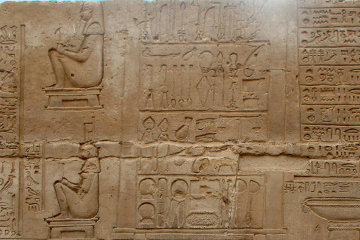Alexander's Birth Stool
The Greek Alexander Romance is a fanciful account of the life of Alexander the Great written in Alexandria about the third century BC. According to the early part of the work, Alexander was not the son of Phillip of Macedon, but rather of his wife Olympias and of Nectanebo, the last native pharaoh of Egypt before the Persian conquest. In much the same way as the Celts of Britain yearned for the return of Arthur, the Once and Future King, so the Egyptians were pleased to consider that Nectanebo had returned in the person of Alexander, to drive out the hated Persians.
The Romance recounts how Nectanebo used his magic arts to keep his kingdom peaceful and prosperous, but then saw that the gods of Egypt had gone over to support the advancing Persians. Realising that it was hopeless to fight against the divine will, Nectanebo fled to Greece where he made a new career for himself as a soothsayer at the court of Philip of Macedon. There he used his magic arts to seduce the beautiful Olympias, causing himself to appear to her as the god Ammon of Libya (the god of the Siwa oasis).
When the time came for Olympias to give birth, she sat down on the birth-stool and went into labour. Nectanebo stood by her, measuring the courses of the heavenly bodies; he urged her not to hurry in giving birth. "Woman," he said to her, "Contain yourself and struggle against the pressure of Nature. Get up from your chair and take a little walk. Scorpio is dominating the horoscope and the bright Sun, when he sees the beasts of heaven yoked together and going backwards, will turn one who is born at this hour altogether out of heaven."

| |
| In this relief from Kom Ombo the women on the left are sitting on birth stools and the central panel depicts surgical instruments. |
There follows a whole lot of astrological mumbo-jumbo which, if Nectanebo really said to Olympias, must have kept the poor woman "struggling against the pressure of Nature" for most of the night! Of course, it is highly unlikely that Olympias used a birth-stool: Greek women lay or squatted in order to give birth. The Romance is projecting Egyptian customs into its version of Greek history, and the Egyptians did use birth stools.
We have a reference to this custom in the Biblical book of Exodus, when Pharaoh commanded the Hebrew midwives to kill any male babies at birth. As the King James Version put it, "'When ye do the office of a midwife to the Hebrew women and see them upon the stools, if it be a son, then ye shall kill him.'" (Exodus 1:16) The midwives evaded the distasteful duty by claiming that Hebrew women gave birth more quickly than Egyptian women so that the baby was already born by the time the midwife arrived on the scene.
It is not recorded what the learned divines of the sixteenth century made of this reference to "stools" but they must be honoured for translating the Hebrew exactly, even though it made no sense to them. Today we are aware of the wide variety of methods and positions used in giving birth in different countries and in particular, we are aware of this Egyptian custom of the birth stool.
As far as I know, no example of such a birth stool has ever been found in Egypt, but there are a number of pictures depicting this item of furniture. Hatshepsut, on the walls of her mortuary temple at Deir el-Bahri, tried to assert her claim to kingship by the usual fiction that her father was not Thutmoses II, but really the god Ammon, who came into her mother in the form of Thutmoses. As further proof, she depicts various gods attending on her mother as she gives birth and the royal parent is shown sitting upright on a curious chair like the one shown here. Presumably the seat of the chair had a hole in it, similar to a modern toilet seat, but as the Egyptians always gave us a two-dimensional, side view of the chair, there is no way of knowing.
Scholars have speculated about the purpose of the lower level of the chair. The most resonable explanation is that it served to catch the child when it emerged — though what the midwife (or even the mother) was doing at that time we do not know.
If this explanation is correct, then at least Hatshepsut was luckier than poor Alexander, who seems to have been dropped on his head! Having kept Olymias waiting while Saturn, the Moon, Venus, Mars and Mercury passed across the heavens, Nectanebo finally gave the go-ahead for the birth to take place.
"Sit down now, your majesty, on the chair of benefaction and make your labours more frequent and energetic. Jupiter, the lover of virgins, who was himself pregnant with Dionysus in his thigh, is now high in the clear heaven, turning into horned Ammon between Aquarius and Pisces and designating an Egyptian as world-ruler. Give birth NOW!" And as the child fell to the ground there were great claps of thunder and flashes of lightning, so that all the world was shaken.





